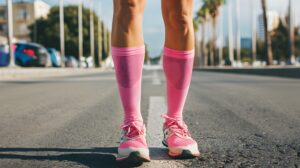Varicose Veins and Compression Stockings: Do They Really Help?
Varicose veins, the swollen, twisted veins often visible just under the skin, are more than a cosmetic concern. They are actually part of a larger family of disease known as chronic venous insufficiency, and can cause discomfort, pain, and even lead to more serious health issues like skin ulcers and blood clots. One common recommendation for managing varicose veins is the use of compression stockings. But do they really help?
How Compression Stockings Work
Compression stockings apply graduated pressure to the legs, with the highest pressure at the ankle and gradually decreasing up the leg. This helps to promote blood flow back towards the heart, reducing swelling and the risk of blood pooling. The stockings also support the veins to reduce abnormal (backwards) flow of blood.
Benefits of Compression Stockings
Reduction of Symptoms: Compression stockings can alleviate symptoms associated with varicose veins, such as swelling, pain, and a feeling of heaviness. By improving blood circulation, they help reduce these discomforts. Compression stocking therapy is considered a Grade 1 recommendation by medical societies for all forms of chronic venous insufficiency.
Prevention of Disease Progression: For those with mild varicose veins or at risk of developing them, wearing compression stockings can prevent the condition from worsening. They provide support to the vein walls and valves, reducing the likelihood of further vein damage.
Post-Surgical Support: After treatments such as vein stripping or sclerotherapy, compression stockings are often recommended to aid healing and improve outcomes. They help maintain the effects of the treatment and prevent the formation of new varicose veins.
Types of Compression Stockings
Compression stockings come in various styles and levels of compression. The most common types include:
Pantyhose-Style: These stockings cover the entire leg and are often favored for their overall support and seamless appearance. They are a good option for those needing compression in the thighs and hips as well as the lower legs.
Thigh-High: These stockings provide support up to the thigh and are often preferred for their comfort and ease of wear. They can be more practical for daily use, especially in warmer climates or for those who find pantyhose-style stockings too restrictive.
Knee-High: Ideal for those who only need support in the lower leg, knee-high stockings are easier to put on and can be worn with regular clothing without being noticeable.
Skin Adhesives and Comfort
One challenge with compression stockings is keeping them in place, especially for thigh-high and knee-high styles. Skin adhesives can be used to ensure the stockings stay up without rolling down, which can cause discomfort and reduce effectiveness. These adhesives are designed to be gentle on the skin and easy to remove, and can be purchased over-the-counter or online (e.g. Amazon).
Choosing the right style and fit is crucial for comfort and effectiveness. Pantyhose-style stockings provide full coverage but can be cumbersome to put on and take off. Thigh-high stockings offer a balance between support and ease of use, though some may find them prone to slipping without adhesives. Knee-high stockings are convenient but may not provide sufficient compression for those needing support above the knee.
Using Compression Stockings Correctly
To gain the maximum benefit from compression stockings, it is important to wear them correctly. Many patients buy incorrect stockings from a drug store or online reseller, and ask us why they are not feeling symptom relief. Here are some tips:
Proper Fit and Compression: Ensure the stockings fit well. Ill-fitting stockings can cause more harm than good. Measurements by a trained professional should be taken at different points on the leg to find the right size. The appropriate compression level is prescribed by our vein center based on our ultrasound diagnostic testing.
Consistent Use: For best results, wear compression stockings daily, especially during activities that involve prolonged standing or sitting. Put them on in the morning before swelling begins and remove them before bed.
Care and Maintenance: Wash compression stockings regularly to maintain their elasticity and hygiene. Follow the manufacturer’s instructions for washing and drying.
A Practical and Beneficial Solution
By improving blood circulation and supporting vein function, compression stockings can alleviate symptoms and prevent disease progression. Choosing the right style and fit, and using skin adhesives when necessary, can enhance comfort and effectiveness. For those suffering from varicose veins or at risk of developing them, compression stockings offer a practical and beneficial solution.
